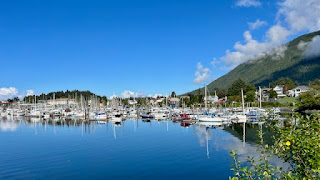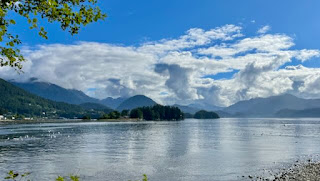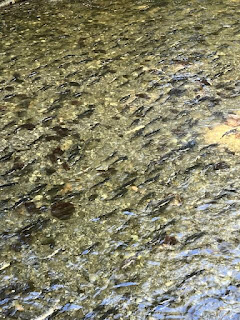20240914 Saturday, September 14, 2024- Sitka
The ship must have crossed some big open water during the night because the ship was rocking quite a bit during the wee hours of the night. When we awoke, the ship was back to threading its way between smaller islands and channels. There were some low clouds wandering between islands that were reminiscent of Carl Sandberg’s poem Fog from which the line comes “The fog comes on little cat feet”
We had a light breakfast at Mamsen’s, which is very close to our stateroom. They feature Mamsen’s waffles which are thin and light with fresh berries créme fraich and Brunost cheese, which is brown, tastes like caramel and sticks to the roof of the mouth. It’s not actually a cheese in a classic sense. It is made from the whey of goat’s milk which is boiled down to caramelize the sugars. A little can go a long way.
The ship docked at a purpose built cruise ship dock that is 5 miles from downtown Sitka. It is a very nice modern cruise ship terminal, but it probably can’t accommodate more than one large cruise ship at a time. While we were in Sitka, one of Hurtigruten’s newest hybrid expedition ships was at anchor outside downtown Sitka and ferried its passengers into one of the Marinas in town.
We boarded tourist coaches which took us into town for a brief driving tour through downtown and then across a bridge to Japonica Island which was turned into a military airfield during WWII, but is now a University of Alaska SE campus.
The tour ended at a theatre on the waterfront where we watched a cultural dance show featuring a small troupe of local dancers doing some ethnic Russian/Siberian folk dancing, some modern interpretive dancing, and some American folk and popular dancing as a narrator outlined the transition of the area from being influenced by Russians to being influenced by America. While there was mention of the roles that the local indigenous tribes played, there was disappointingly no coastal Indian dancing demonstrated.
Following the cultural dance presentation, we could have returned to the ship on the tourist coach but there was also a town to cruise ship shuttle that ran about every half hour and used school buses. We elected to stay behind and walk through Sitka. It is not too big of a city to be able to walk through most of its tourist sites within 2-3 hours.
We walked along the waterfront which is dominated by marinas filled with recreational and commercial boats.
At the end of town is a fish hatchery and science center. There was a big local foot race taking place, so we saw a lot of high schoolers wearing numbers milling about before the starting gun sounded and they bolted off. The fish hatchery is right on the waterfront. There were salmon spawning up a small fish ladder they had constructed. Not too much further along the shoreline is the Indian River, where spawning salmon filled the river.
The Sitka National Historical Park is at the site of an original Tlingit fort. The history of the Russians in Alaska is a rather ugly one. As the Mongol empire collapsed, the Russians spread east primarily by enslaving Mongol and Siberian tribes and forcing them to hunt for fur in exchange for the lives of their women and children. As they spread eastward, they eventually ran out of furs and slaves. They hired the Dutch explorer Vitus Bering to map what was further east, and when he came back with sea otter fur, which is the densest fur of any mammal with over 1000 hairs per inch, the Russians sent ships across the Pacific to then enslave the Aleuts and force them to hunt seals and otters to near extinction by holding their women and children for ransom.
As they worked their way further east and south, they encountered the more resource rich and socially developed coastal Indian tribes including the Tlingit and Haida who weren’t about to let the Russians enslave them and steal their lands. While the Inuits and Aleuts were primarily nomadic hunter gatherers, the Southeast Coastal Indian tribes had coastal cities, trade routes, and political structures. They called this city Shee At’iká. The Russian American Company built New Archangel in the same bay using Aleut slaves. For a while they coexisted but eventually the Tlingt had enough of the intrusion and not wanting to become enslaved like the Aleuts, they drove the Russians out in 1802. Knowing the Russians would be back, they constructed a wooden fortress. When the Russians came back in 1804 with Naval ships equipped with cannons, they repulsed the first attack and a 5 day siege, but a lucky cannon shot blew up a war canoe that was transporting the Tlingit’s gunpowder, ammunition and lead warriors. That was probably a strategic faux pax putting all their eggs in one basket. The Tlingit retreated into the mountains to the north and were banned from the area. However, the Russians had never learned to become self sufficient. They couldn’t fish or hunt marine mammals, and relied on meat and flour imported from settlements in Northern California. Eventually, trade began again between the Tlingit as a matter of survival for the Russians. It was actually Russia’s failings in the Crimean wars that lead to Russia withdrawing from Alaska. With a nearly bankrupt treasury, and the Russians fearing the British would take Alaska from them, and the Russians not even being certain they could ever become self sufficient in such a cold and wet environment, they turned to the US, which was eager to fulfill the dogma of Manifest Destiny, and sold it to the US for 2 cents per acre.
That transaction between the Russians and Americans took place without any input from the coastal Indian tribes who argued that they had never been subjugated by the Russians and that the Russians were never the proper owners of tribal lands that they had occupied for thousands of years. It was kind of like Zillow scammers selling places they didn’t own. It took until 1971 for the Alaska Native Claims Settlement Act to begin to correct those wrongs.
The Sitka National Historical Park now has several nice walking trails with totem poles around the point and to the mouth of the Indian River.
We walked up the river a ways to the Sitka Raptor Center, which is a private raptor rehabilitation center/zoo. It’s not free ($16 adult admission) but they have a number of recovering eagles, owls and other raptors that can be viewed en route to the gift shop and admissions lobby, so we got to see a fair number of raptors for free.
Upon returning to the ship, we had lunch at the poolside grill, which makes high quality burgers with fries and onion rings. They have avocado, bacon, lettuce, tomatoes, cheeses, red onion relish and arugula you can customize your burgers with, and a small salad bar as well.
After lunch, we watched a lecture on wolves in our stateroom that was recorded from earlier in the cruise. It’s nice that the lectures are recorded and can be watched on demand. It’s certainly more comfortable to nod off in our bed than in the theater chairs.
While the ship was still docked, we had high tea in the Winter Garden. We sat off to the side rather than under the glass roof, and it was quieter. As a bonus, we were able to watch a humpback whale and its calf feeding about a quarter mile from the ship.
We booked another late dinner in the Chef’s Table which has changed its menu from Asian Fusion to a California themed menu. This gave us time to enjoy the thermal spa.































No comments:
Post a Comment
Note: Only a member of this blog may post a comment.